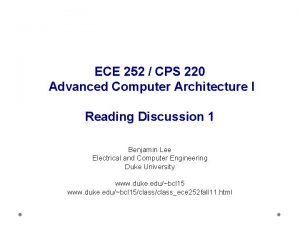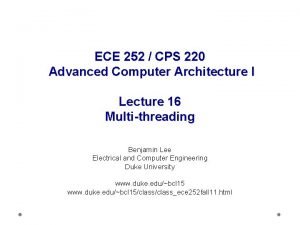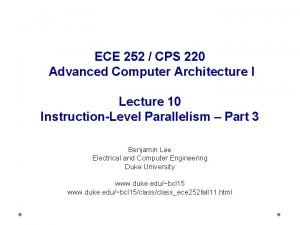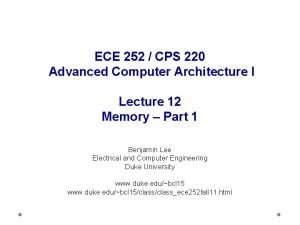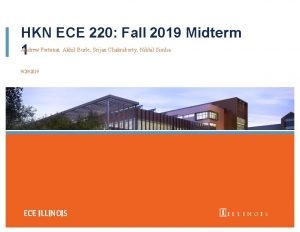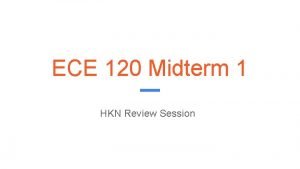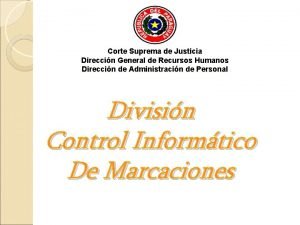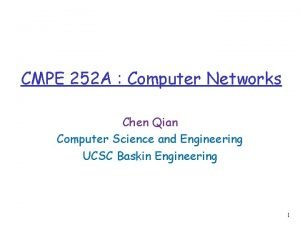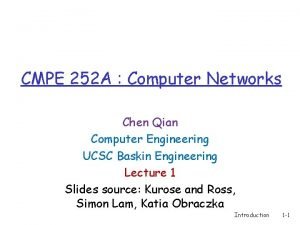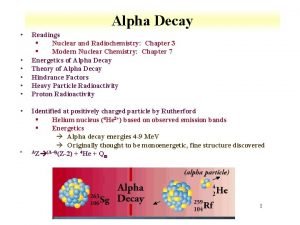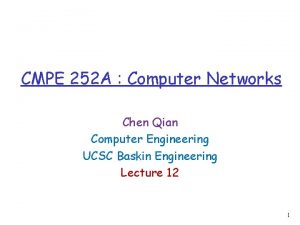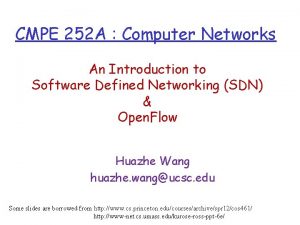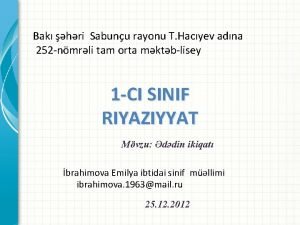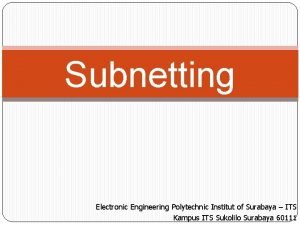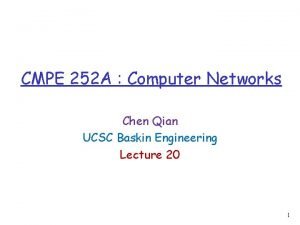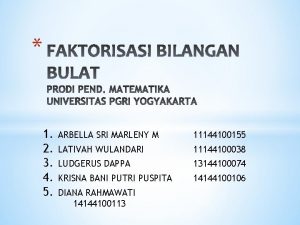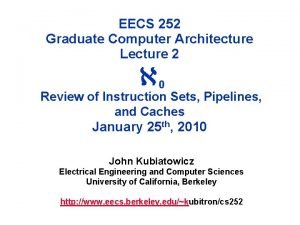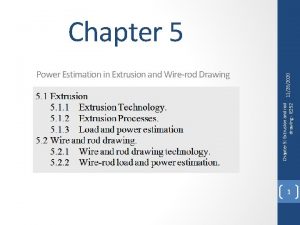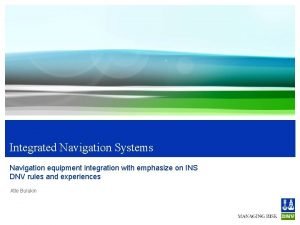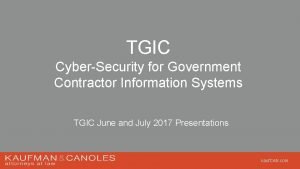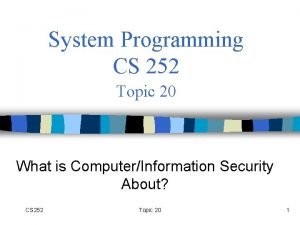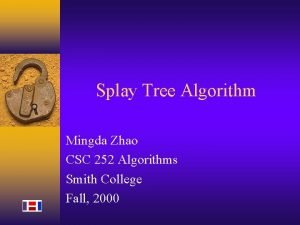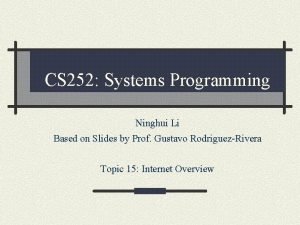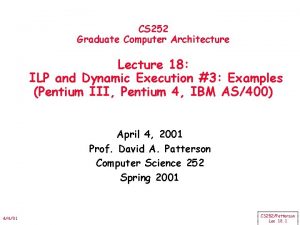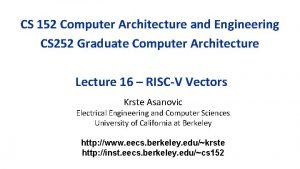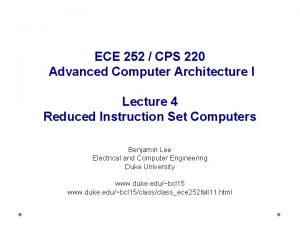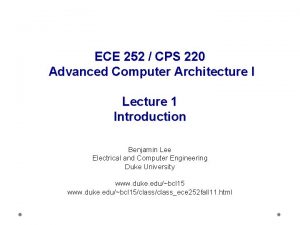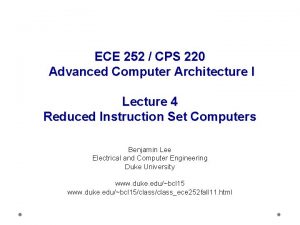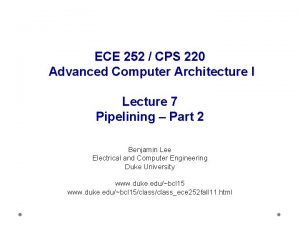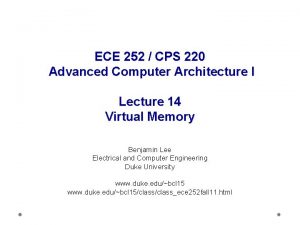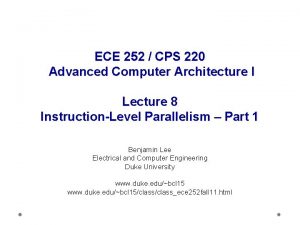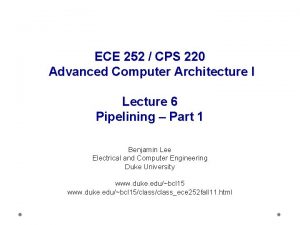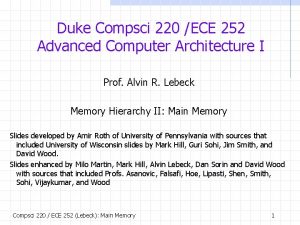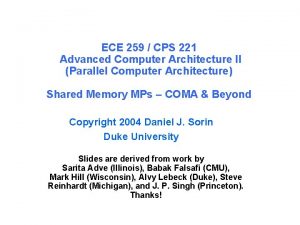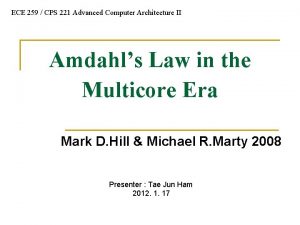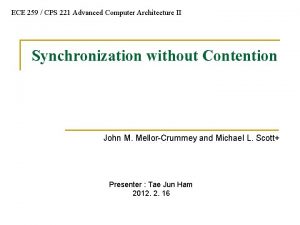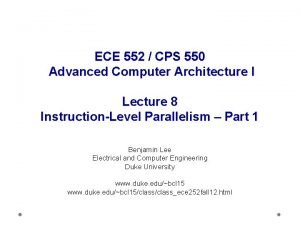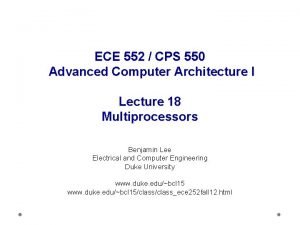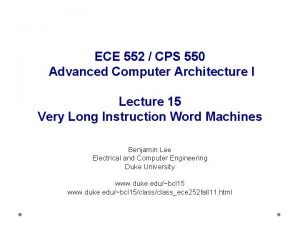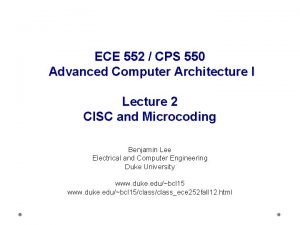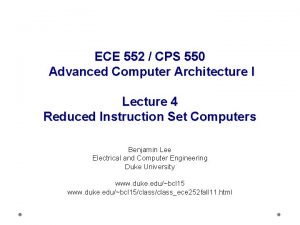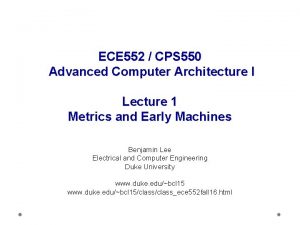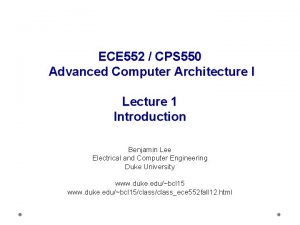ECE 252 CPS 220 Advanced Computer Architecture I









































- Slides: 41

ECE 252 / CPS 220 Advanced Computer Architecture I Lecture 10 Instruction-Level Parallelism – Part 3 Benjamin Lee Electrical and Computer Engineering Duke University www. duke. edu/~bcl 15/class_ece 252 fall 11. html

ECE 252 Administrivia 4 October – Homework #2 Due - Use blackboard forum for questions - Attend office hours with questions - Email for separate meetings 4 October – Class Discussion Roughly one reading per class. Do not wait until the day before! 1. Srinivasan et al. “Optimizing pipelines for power and performance” 2. Mahlke et al. “A comparison of full and partial predicated execution support for ILP processors” 3. Palacharla et al. “Complexity-effective superscalar processors” 4. Yeh et al. “Two-level adaptive training branch prediction” ECE 252 / CPS 220 2

ECE 252 Administrivia 6 October – Midterm Exam - 75 minutes, in-class - Closed book, closed notes exam 1. 2. 3. 4. 5. 6. Performance metrics – performance, power, yield Technology – trends that changed architectural design History – Instruction sets (accumulator, stack, index, general-purpose) CISC – microprogramming, writing microprogram fragments Pipelining – Performance, hazards and ways to resolve them Instruction-level Parallelism – mechanisms to dynamically detect data dependences and to manage instruction flow (Scoreboard, Tomasulo, Physical Register File) 7. Speculative Execution – exception handling, branch prediction 8. Readings – High-level questions, not details ECE 252 / CPS 220 3

Tomasulo Implementation Renaming Table & Register File Ins# use exec op p 1 src 1 p 2 src 2 Reorder Buffer Load Unit FU FU t 1 t 2. . tn Store Unit < t, result > - Decode stage allocates instruction template (i. e. , tag t) and stores tag in register file. - When instruction completes, tag is de-allocated. ECE 252 / CPS 220 6

Tomasulo’s Structures Reorder Buffer (ROB) -- buffers in-flight instructions in program order -- supports in-order commit, precise exceptions -- e. g. , instruction#, use, exec, op Reservation Stations -- tracks renamed source operands -- if operands ready, contains value (e. g. , v 1) -- if operands pending, contains tag (e. g. , t 1) -- may be combined with ROB (e. g. , our example) -- may be distributed across functional units Renaming Table -- if write committed, points to register file (e. g. , F 1) -- if write pending, points to ROB entry (e. g. , t 1) -- Rename registers (e. g. , F 1) with ROB tags (e. g. , t 1) Register File -- contains architected state, committed values Common Data Bus (CDB) -- functional units broadcast computed values -- broadcast includes <tag, result> ECE 252 / CPS 220 7

Tomasulo’s Pipeline 1. Fetch 2. Dispatch -- Decode instruction -- Stall if structural hazard in ROB -- Allocate ROB entry and rename using ROB tags -- Read source operands when they are ready 3. Execute -- Issue instruction when all operands ready -- Instructions may issue out-of-order 4. Complete -- Stall if structural hazard on the common data bus -- Broadcast tag and completed result -- Mark ROB entry as complete -- Instructions may complete out-of-order 5. Retire -- Stall if oldest instruction (head of ROB) not complete -- Handle any interrupts -- Write-back value for oldest instruction to register file or mem -- Free ROB entry -- Instructions retire in-order ECE 252 / CPS 220 8

Physical Register File Tomasulo Performance Limitations -- Too much data movement on common data bus -- Multi-input multiplexors, long buses impact clock frequency Alternative Approach to Register Renaming -- Eliminate architectural register file (e. g. , R 0 -R 31, F 1 -F 8) -- Add larger physical register file, which holds all values (e. g. , P 0 -Pn, n>>32) -- Modify rename table to map architected registers to physical registers -- Add free list to manage unallocated physical registers -- Reorder buffer tracks ready operands, supports in-order retire, supports free list management ECE 252 / CPS 220 9

Lifetime of Physical Registers -- Architected registers are those defined by the instruction set architecture -- Register renaming can be implemented in two ways -- Rename with buffer tags -- insert speculatively computed values into ROB -- Rename with physical registers – hold committed and speculative values With Architected Registers 1. ld R 1, (R 3) 2. add R 3, R 1, 4 3. sub R 6, R 7, R 9 4. add R 3, R 6 5. ld R 6, (R 1) 6. add R 6, R 3 7. st R 6, (R 1) 8. ld R 6, (R 11) With Physical Registers ld P 1, (Px) add P 2, P 1, 4 sub P 3, Py, Pz add P 4, P 2, P 3 ld P 5, (P 1) add P 6, P 5, P 4 st P 6, (P 1) ld P 7, (Pw) -- Every instruction’s destination register R* renamed to physical register P* -- When do we reuse physical register? When next write of same architected register commits. Example: Reuse P 2 when instruction 4 commits ECE 252 / CPS 220 10

Physical Register Management Rename Table -- Maps architected registers (e. g. , R*) to physical registers (e. g. , P*) -- Rename table identifies physical register P* that contains the value of R* -- Example: MIPS has 32 architected registers so rename table has 32 entries. -- Microarchitecture might have N >> 32 physical registers. Physical Registers -- Contain N>>32 registers that can hold committed data. -- Committed data is present when “p” flag is set. Free List -- List of physical registers available for renaming. -- Stall pipeline if there are insufficient physical registers Reorder Buffer -- Issue logic checks state of instructions to determine if operand values present -- Tracks sequence of renamings for the same architected register ECE 252 / CPS 220 11

Physical Register Management -- After the fetch stage, instruction enters decode stage. -- Decode stage (1) extracts architected registers, (2) renames to physical registers, and (3) inserts instruction into reorder buffer. Every instruction’s destination register is renamed! Eliminates WAW/WAR hazards. Renaming for instruction “op Rd, R 1, R 2” requires the following steps: i. Lookup source registers (R 1, R 2) in rename table. Insert corresponding physical register (P<y>, P<z>) into ROB. ii. If values for P<y>, P<z> are present, set “p” flag in ROB. iii. Lookup destination register (Rd) in rename table. Suppose Rd already renamed to P<w>. Because we rename Rd in step iii, this is the last instruction for which P<w> is valid. Denote as last physical register (LPRd) in ROB. Required for managing free list. iv. Rename Rd to P<x>, which is next available register from free list. Denote as current physical register (PRd) in ROB. Issue logic sends instruction to execution units when both source registers present ECE 252 / CPS 220 12

Renaming R 1 to P 0 R 1 R 2 R 3 R 4 R 5 R 6 R 7 Rename Table P 8 P 0 P 7 P 5 P 6 ROB use ex op X ld Physical Regs P 0 P 1 P 2 P 3 P 4 P 5 P 6 P 7 P 8 <R 6> <R 7> <R 3> <R 1> p p Free List P 0 P 1 P 3 P 2 P 4 1. 2. 3. 4. 5. ld add sub add ld R 1, R 3, R 6, 0(R 3) R 1, 4 R 7, R 6 R 3, R 6 0(R 1) Pn p 1 PR 1 p P 7 p 2 PR 2 Rd R 1 LPRd P 8 PRd P 0 PR 1/2: src physical regs p 1/2: set when physical reg values are present Rd: dest architected reg LPRd: last dest physical reg PRd: new dest physical reg ECE 252 / CPS 220 13

Renaming R 3 to P 1 R 0 R 1 R 2 R 3 R 4 R 5 R 6 R 7 Rename Table P 8 P 0 P 7 P 1 P 5 P 6 ROB Physical Regs P 0 P 1 P 2 P 3 P 4 P 5 P 6 P 7 P 8 <R 6> <R 7> <R 3> <R 1> p p Free List P 0 P 1 P 3 P 2 P 4 1. 2. 3. 4. 5. ld add sub add ld R 1, R 3, R 6, 0(R 3) R 1, 4 R 7, R 6 R 3, R 6 0(R 1) Pn use ex op p 1 PR 1 x ld p P 7 x add P 0 p 2 PR 2 Rd LPRd R 1 P 8 R 3 P 7 PRd P 0 P 1 PR 1/2: src physical regs p 1/2: set when physical reg values are present Rd: dest architected reg LPRd: last dest physical reg PRd: new dest physical reg ECE 252 / CPS 220 14

Renaming R 6 to P 3 R 0 R 1 R 2 R 3 R 4 R 5 R 6 R 7 Rename Table P 8 P 0 P 7 P 1 P 5 P 3 P 6 P 0 P 1 P 2 P 3 P 4 P 5 P 6 P 7 P 8 <R 6> <R 7> <R 3> <R 1> p p Free List P 0 P 1 P 3 P 2 P 4 1. 2. 3. 4. 5. ld add sub add ld R 1, R 3, R 6, 0(R 3) R 1, 4 R 7, R 6 R 3, R 6 0(R 1) Pn ROB use ex x Physical Regs op p 1 PR 1 ld p P 7 add P 0 sub p P 6 ECE 252 / CPS 220 p 2 PR 2 p P 5 Rd LPRd R 1 P 8 R 3 P 7 R 6 P 5 PRd P 0 P 1 P 3 PR 1/2: src physical regs p 1/2: set when physical reg values are present Rd: dest architected reg LPRd: last dest physical reg PRd: new dest physical reg 15

Renaming R 3 to P 2 R 0 R 1 R 2 R 3 R 4 R 5 R 6 R 7 Rename Table P 8 P 0 P 7 P 1 P 2 P 5 P 3 P 6 P 0 P 1 P 2 P 3 P 4 P 5 P 6 P 7 P 8 <R 6> <R 7> <R 3> <R 1> p p Free List P 0 P 1 P 3 P 2 P 4 1. 2. 3. 4. 5. ld add sub add ld R 1, R 3, R 6, 0(R 3) R 1, 4 R 7, R 6 R 3, R 6 0(R 1) Pn ROB use ex x x Physical Regs op p 1 PR 1 ld p P 7 add P 0 sub p P 6 add P 1 ECE 252 / CPS 220 p 2 PR 2 p P 5 P 3 Rd R 1 R 3 R 6 R 3 LPRd P 8 P 7 P 5 P 1 PRd P 0 P 1 P 3 P 2 PR 1/2: src physical regs p 1/2: set when physical reg values are present Rd: dest architected reg LPRd: last dest physical reg PRd: new dest physical reg 16

Renaming R 6 to P 4 R 0 R 1 R 2 R 3 R 4 R 5 R 6 R 7 Rename Table P 8 P 0 P 7 P 1 P 2 P 5 P 3 P 4 P 6 P 0 P 1 P 2 P 3 P 4 P 5 P 6 P 7 P 8 <R 6> <R 7> <R 3> <R 1> p p Free List P 0 P 1 P 3 P 2 P 4 1. 2. 3. 4. 5. ld add sub add ld R 1, R 3, R 6, 0(R 3) R 1, 4 R 7, R 6 R 3, R 6 0(R 1) Pn ROB use ex x x Physical Regs op p 1 PR 1 ld p P 7 add P 0 sub p P 6 add P 1 ld P 0 ECE 252 / CPS 220 p 2 PR 2 p P 5 P 3 Rd R 1 R 3 R 6 LPRd P 8 P 7 P 5 P 1 P 3 PRd P 0 P 1 P 3 P 2 P 4 PR 1/2: src physical regs p 1/2: set when physical reg values are present Rd: dest architected reg LPRd: last dest physical reg PRd: new dest physical reg 17

Physical Register Management R 0 R 1 R 2 R 3 R 4 R 5 R 6 R 7 Rename Table P 8 P 0 P 7 P 1 P 2 P 5 P 3 P 4 P 6 P 0 P 1 P 2 P 3 P 4 P 5 P 6 P 7 P 8 <R 1> <R 6> <R 7> <R 3> <R 1> p p p Free List P 0 P 1 P 3 P 2 P 4 1. 2. 3. 4. 5. P 8 ld add sub add ld R 1, R 3, R 6, 0(R 3) R 1, 4 R 7, R 6 R 3, R 6 0(R 1) Pn ROB use ex x x x Physical Regs op ld add sub add ld ECE 252 / CPS 220 p 1 PR 1 p P 7 p P 0 p P 6 P 1 p P 0 p 2 PR 2 p P 5 P 3 Rd R 1 R 3 R 6 LPRd P 8 P 7 P 5 P 1 P 3 PRd P 0 P 1 P 3 P 2 P 4 Execute & Commit 18

Physical Register Management R 0 R 1 R 2 R 3 R 4 R 5 R 6 R 7 Rename Table P 8 P 0 P 7 P 1 P 2 P 5 P 3 P 4 P 6 P 0 P 1 P 2 P 3 P 4 P 5 P 6 P 7 P 8 <R 1> <R 3> p p <R 6> <R 7> <R 3> p p p Free List P 0 P 1 P 3 P 2 P 4 1. 2. 3. 4. 5. P 8 P 7 ld add sub add ld R 1, R 3, R 6, 0(R 3) R 1, 4 R 7, R 6 R 3, R 6 0(R 1) Pn ROB use ex x x x Physical Regs op p 1 PR 1 ld p P 7 add p P 0 sub p P 6 add p P 1 ld p P 0 ECE 252 / CPS 220 p 2 PR 2 p P 5 P 3 Rd LPRd R 1 P 8 R 3 P 7 R 6 P 5 R 3 P 1 R 6 P 3 PRd P 0 P 1 P 3 P 2 P 4 Execute & Commit 19

Active Instruction Window in ROB (older instructions) ld r 1, (r 3) add r 3, r 1, r 2 sub r 6, r 7, r 9 add r 3, r 6 ld r 6, (r 1) add r 6, r 3 st r 6, (r 1) ld r 6, (r 1) (newer instructions) Cycle (t) ECE 252 / CPS 220 Commit Execute Fetch … ld r 1, (r 3) add r 3, r 1, r 2 sub r 6, r 7, r 9 add r 3, r 6 ld r 6, (r 1) add r 6, r 3 st r 6, (r 1) ld r 6, (r 1) … Cycle (t + 1) 20

Superscalar Register Renaming -- During decode, instruction is allocated new physical register for dest -- Instruction’s source registers renamed to physical register with newest value -- Execution unit only sees physical register numbers. -- Does this work? Inst 1 Op Update Mapping Dest Src 1 Src 2 Op Write Ports Read Addresses Op ECE 252 / CPS 220 Rename Table Read Data PDest PSrc 1 PSrc 2 Op Dest Src 1 Src 2 Inst 2 Register Free List PDest PSrc 1 PSrc 2 21

Superscalar Register Renaming Update Mapping Must check for RAW hazards between instructions issuing in same cycle. If RAW hazard, pass Inst 1’s Pdest to Inst 2’s PSrc 1 or Op PSrc 2. ECE 252 / CPS 220 Dest Src 1 Src 2 Op Read Addresses Write Ports Inst 1 Op Rename Table Read Data PDest PSrc 1 PSrc 2 Op Inst 2 Dest Src 1 Src 2 =? Register Free List PDest PSrc 1 PSrc 2 22

Memory Dependencies st ld r 1, j(r 2) r 3, k(r 4) When can we execute the load? ECE 252 / CPS 220 23

In-Order Memory Queue Execute all loads and stores in program order Load and store cannot leave ROB and commit architected state until all previous loads and stores have completed execution Can still execute loads speculatively and out-of-order with respect to other instructions. ECE 252 / CPS 220 24

Out-of-order Loads Conservative out-of-order load execution st r 1, j(r 2) ld r 3, k(r 4) -- Split execution of store instruction into two phases -- Address calculation and data write -- Can execute load before store if addresses known and j(r 2) != k(r 4) -- Each load address compared with addresses of previous uncommitted stores -- Don’t execute load if any previous store address not known ECE 252 / CPS 220 25

Load Address Speculation st ld r 1, j(r 2) r 3, k(r 4) -- Guess that j(r 4) != k(r 2) -- Execute load before store address is known -- Need to hold all completed but uncommitted load/store addresses in program order -- Later, if we find r 4 == r 2, squash load and all following instructions -- Large penalty for inaccurate address speculation ECE 252 / CPS 220 26

Speculative Loads/Stores Just like register updates, stores should not modify the memory until after the instruction is committed. A speculative store buffer is a structure introduced to hold speculative store data ECE 252 / CPS 220 27

Speculative Store Buffer Load Address V V V S S S Tag Tag Tag Data Data L 1 Data Cache Tags Data Store Commit Path Load Data -- On store execute: mark entry valid (V) and speculative (S), save data and tag of instruction -- On store commit: clear speculative bit and eventually move data to cache -- On store abort: clear valid bit ECE 252 / CPS 220 28

Speculative Store Buffer Load Address V V V S S S Tag Tag Tag Data Data L 1 Data Cache Tags Data Store Commit Path Load Data -- If data in both store buffer and cache, which should we use? -- Speculative store buffer -- If same address in store buffer twice, which should we use? -- Youngest store that is older than load ECE 252 / CPS 220 29

Speculative Datapath Branch Prediction kill Update predictors Branch Resolution kill PC Fetch Decode & Rename kill Reorder Buffer Commit Reg. File Branch ALU MEM Unit Execute ECE 252 / CPS 220 Store Buffer D$ 30

Branch Prediction Motivation -- Branch penalties limit performance of deeply pipelined processors -- Modern branch predictors have high accuracy (>95%) and can significantly reduce branch penalties Hardware Support -- Prediction structures: branch history tables, branch target buffer, etc. -- Mispredict recovery mechanisms: -- Separate instruction execution and instruction commit -- Kill instructions following branch in pipeline -- Restore architectural state to correct path of execution ECE 252 / CPS 220 31

Static Branch Prediction backward 90% JZ forward 50% JZ On average, probability a branch is taken is 60 -70%. But branch direction is a good predictor. ISA can attach preferred direction semantics to branches (e. g. , Motorola MC 8810, bne 0 prefers taken, beq 0 prefers not taken). ISA can allow choice of statically predicted direction (e. g. , Intel IA-64). Can be 80% accurate. ECE 252 / CPS 220 32

Dynamic Branch Prediction Learn from past behavior Temporal Correlation -- The way a branch resolves may be a good predictor of the way it will resolve at the next execution Spatial Correlation -- Several branches may resolve in a highly correlated manner (preferred path of execution in the application) ECE 252 / CPS 220 33

2 -bit Branch Predictor Use two-bit saturating counter. Changes prediction after two consecutive mistakes. ECE 252 / CPS 220 34

Branch History Table (BHT) Fetch PC 0 0 k I-Cache BHT Index 2 k-entry BHT, 2 bits/entry Instruction Opcode offset + Branch? Target PC Taken/¬Taken? BHT is an array of 2 -bit branch predictors, indexed by branch PC 4 K-entry branch history table, 80 -90% accurate ECE 252 / CPS 220 35

Two-Level Branch Prediction Pentium Pro uses the result from the last two branches to select one of the four sets of BHT bits (~95% correct) 00 Fetch PC k 2 -bit global branch history shift register Shift in Taken/¬Taken results of each branch Taken/¬Taken? ECE 252 / CPS 220 36

Branch Target Buffer (BTB) predicted target BPb Branch Target Buffer (2 k entries) IMEM k PC target BP BHT only predicts branch direction (taken, not taken). Cannot redirect instruction flow until after branch target determined. Store target with branch predictions. During fetch – if (BP == taken) then n. PC=target, else n. PC=PC+4 Later – update BHT, BTB ECE 252 / CPS 220 37

Branch Target Buffer (BTB) – v 2 I-Cache PC Entry PC Valid predicted target PC valid target k = match Keep both branch PC and target PC in the BTB If match fails, PC+4 is fetched Only taken branches and jumps held in BTB ECE 252 / CPS 220 38

Mispredict Recovery In-order execution No instruction following branch can commit before branch resolves Kill all instructions in pipeline behind mis-predicted branch Out-of-order execution Multiple instructions following branch can complete before one branch resolves ECE 252 / CPS 220 39

In-order Commit In-order Fetch Decode Out-of-order In-order Reorder Buffer Commit Kill Inject handler PC Execute Exception? -- Instructions fetched, decoded in-order (entering the reorder buffer -- ROB) -- Instructions executed out-of-order -- Instructions commit in-order (write back to architectural state) -- Temporary storage needed in ROB to hold results before commit ECE 252 / CPS 220 40

Branch Misprediction in Pipeline Inject correct PC Branch Prediction Kill PC Fetch Decode Branch Resolution Kill Reorder Buffer Commit Complete Execute -- Can have multiple unresolved branches in reorder buffer -- ROB -- Can resolve branches out-of-order by killing all instructions in ROB that follow a mispredicted branch ECE 252 / CPS 220 41

Mispredict Recovery t t vv t v Rename Table r 1 Rename Snapshots Register File r 2 Ptr 2 next to commit Ins# use exec op p 1 src 1 p 2 src 2 pd dest data rollback next available t 1 t 2. . tn Ptr 1 next available Reorder Buffer Load Unit FU FU FU Store Unit Commit < t, result > Take snapshot of register rename table at each predicted branch, recover earlier snapshot if branch mispredicted ECE 252 / CPS 220 42

Acknowledgements These slides contain material developed and copyright by - Arvind (MIT) - Krste Asanovic (MIT/UCB) - Joel Emer (Intel/MIT) - James Hoe (CMU) - John Kubiatowicz (UCB) - Alvin Lebeck (Duke) - David Patterson (UCB) - Daniel Sorin (Duke) ECE 252 / CPS 220 43
 Cps 220
Cps 220 Cps 220
Cps 220 Cps 220
Cps 220 Ece 252
Ece 252 Ece 220 uiuc
Ece 220 uiuc Hkn review session
Hkn review session Ec 6009
Ec 6009 Bus design in computer architecture
Bus design in computer architecture Difference between organisation and architecture
Difference between organisation and architecture Design of basic computer
Design of basic computer Acordada 961/15
Acordada 961/15 Cmpe 252
Cmpe 252 Qian chen ucsc
Qian chen ucsc Cf-252 decay scheme
Cf-252 decay scheme Simplified radical of 108
Simplified radical of 108 Hops history questions
Hops history questions Cmpe 252
Cmpe 252 Cmpe 252
Cmpe 252 4 en hexadecimal
4 en hexadecimal 252 nömrəli məktəbin müəllimləri
252 nömrəli məktəbin müəllimləri 252 netmask
252 netmask Skema ip address
Skema ip address 252 basics
252 basics Cmpe 252
Cmpe 252 Fpb dari 252
Fpb dari 252 252
252 Ie 252
Ie 252 Factorizacion prima de 504
Factorizacion prima de 504 Msc.252(83)
Msc.252(83) Dfars 252
Dfars 252 Dfars 252 204 7012
Dfars 252 204 7012 Cs 252
Cs 252 Csc 252
Csc 252 Florida statute 252
Florida statute 252 252 lec
252 lec Purdue cs 252
Purdue cs 252 Cs 252
Cs 252 Cs 252
Cs 252 Cs 252
Cs 252 Cs 252
Cs 252 Cs 252
Cs 252 Cs 252
Cs 252
